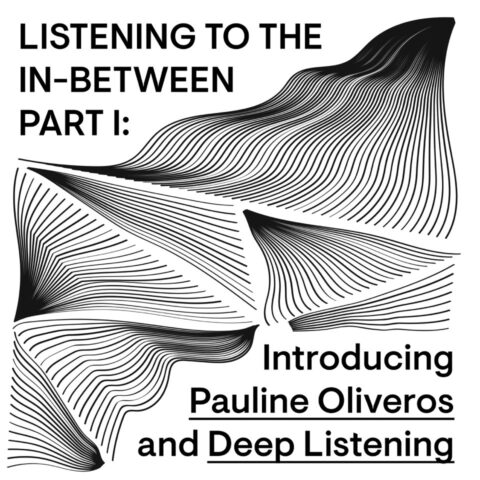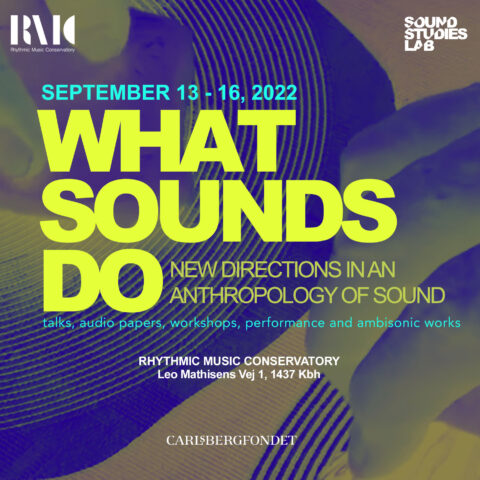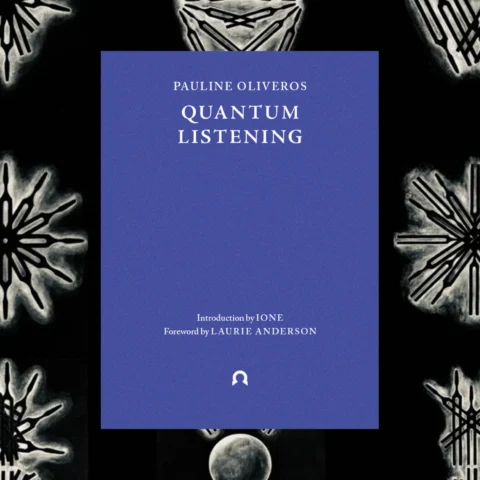A message from the author:
The following is writing from an earlier time in my recent research project, Wayback Sound Machine: Sound through time, space, and place. It felt an appropriate beginning to share here as the first part of the ongoing series, “Wayback Sound Machine- a constellation of sounding time”, that will be exploring various works and writings approaching the concept of sound back through time. I will be publishing the call for work shortly, and hope to hear from some of you Sonic Field readers. Until soon!

Sound has a special relationship to emotion, instinct, and memory, both individual and historical. Tapping into an ancient area of our brain, sound provides immediate information telling us where we are, if it is safe, and how we should feel about it. “Based on hearing, listening (from an anthropological point of view) is the very sense of space and of time..,” Roland Barthes wrote in his 1985 essay, Listening. Barthes further notes,
“[N]oises have been the immediate raw materials of a divination, (cledonomancy): to listen is, in an institutional manner, to try to find out what is happening”. (Barthes, 1985: 247)
Or perhaps, what has happened. Artists and sound designers working with and considering sound from the past can create a living archive that would have listeners’ experience one of wonder and sensation, a sonic database that could help us to remember and learn about our heritage, a fluid museum to give voice to the past, while creating new experience and highlighting information within the complexity of our changing soundscapes, over a period that usually defies our comprehension.[1] This essay is on sounding the past, the concept potential, how it is already being used and thought about in time-based media archives, and works that use time-based media archives, what it could mean for our future, and what it could say about our history and our heritage. What should be considered when considering sound’s place within a living archive.
Silence and Silent Film, A Voice From the Past, Towards Future Memory
I would like to address the importance of sound and the archive by initially speaking of silence. Our most famous “silence” in the art world could arguably be 4’33” (1947-48) by composer John Cage. 4 minutes and 33 seconds of a pianist at a piano, hands still, keys untouched, piano unsounded…the idea of still, of doing nothing, of a neutral state…“no neutral surface, no neutral discourse, no neutral theme, no neutral form. Something is neutral only with respect to something else. (Sontag, 1969: IV). Nothing is not what happens; the work is not about hearing silence, but about listening actively to your surroundings. Years later from conceiving this work the composer had had a chance to experience the closest earthly (and manmade) thing we have to real silence, in an anechoic chamber on the Harvard University campus in 1951. Cage later stressed when asked about the experience that, “there is no such thing as silence. Something is always happening that makes sound” (Cage, 1967: 117), and describes how in the chamber he heard both his blood circulating as well as his nervous system operating. The concept of silence implies its opposite, demanding its presence within what we perceive as absence. (Sontag, 1969: IV). Even our memories persist an implied soundtrack if we take that time and focus with them; a memory of a childhood forest though biologically silent has a very specific wind heard through its trees, through its soundtrack.
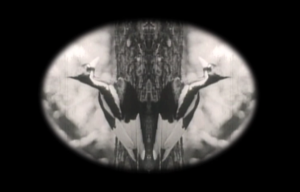
In the Macaulay Library of the Cornell Lab of Ornithology, there as a recording of the critically endangered to extinct bird, the Ivory-billed Woodpecker, made by Doctor Author Allen in 1935.[2] There is a pause in the beginning of the track, a “silence” where we hear the sound of the recording medium itself…ghostly and crackling through time and wear, the medium, for a moment speaks for itself. Through that trumpets the call of a bird gone, then its bill against a tree. More follow, it is not alone; at the time of the recording it was rare, but still not alone. In that time and technology, sound and image were yet to be married by medium, and there exists in archives bits and pieces of the history of this species…a photo here, and illustration there. I found a film that was shot the same year of this recording.[3] Submerged in a shroud of beautifully aged black and white grain, our ghost bird pecks at a tree silently. Separately. The library’s mission statement reads:
Our mission is to collect and preserve recordings of each species’ behavior and natural history, to facilitate the ability of others to collect and preserve such recordings, and to actively promote the use of these recordings for diverse purposes spanning scientific research, education, conservation, and the arts.[4]
The arts, listed with the same import as scientific research, education, and conservation. An artist sounding an archive with care, composition, and design can can allow place to speak, giving voice also to images, making those sounds and images together have a presence in our present. Filmmaker Michael Gitlan, in the production of his film The Birdpeople, knew a recording would transfer within its experience sensory information to help guide his audience to feel and care for this woodpecker of the past. The Macaulay Library archive not only gave him that recording, but encouraged its use and context, writing:
This film looks at birds and birders as curiosities—interweaving artistically rendered footage, sounds, and narrative: live birds and the people watching them; live birds and the people engaged in the scientific ritual of capturing and banding them; stuffed birds and the people who glean new knowledge from specimens. The tale of the Ivory-billed Woodpecker surfaces throughout in book passages, voiceovers of modern-day scientists, offbeat third-person commentary, and a foray into the field with a team of top birders looking for ivory-bills in the Pearl River area of Louisiana in 2002.[5]

We watch Gitlin’s closing scene, and regardless of any thought we had prior on collecting and collections, the Ivory-Billed Woodpecker comes to life for us as a voice of the past in contrast to the lifeless bodies also captured, once again, in front of us. The silent film speaks, blood and breath flow through that bird body. This is a voice from the past weaving through its many mausoleums, making a whole, a possible redemption, and a warning to the future. The Ivory-Billed Woodpecker, is for a moment given presence, giving weight to its silence, made more then a statistic. An archive can give a sound, a voice to the past, a call to the present, an advice for the future…the artist can help guide this.
Out of deep dreamless sleep I was woken, startled by a hollow resonance, a sudden impact of wood on wood. Was the sound an isolated auditory event within my consciousness — a moment of dream without narrative or duration — or was it a real sound from the physical world? The reverberation time was too long for the sound to have emanated from the bedroom. This would imply a sound coming from somewhere else in the house, an echoing space, mysterious and distant. If that was the case, then I could only assume the presence of an intruder, unlikely as a possibility. The sound came from nowhere, belonged nowhere, so had no place in the world except through my description. (Toop, 2010: VII)
Our experience of sound with moving image is both pre-reflective as well as an intentional reflective act towards meaning, utilizing imagination as well as perception. When sounding image from the past, our experience is also one of an artistic inscription, and an author’s sensory instruction.

In 1923 filmmakers Robert and Frances Flaherty brought their children to an island called Savai’I in Samoa to live a year’s time while they made their next feature film, after Nanook, to be called Moana. Similar to their film prior, and the film to come after, there are various staged and embellished elements to the film, leading it to be often called “docufiction”, though at the time of its screening the word “documentary” was for the first time applied to cinema in a review. In 1975, Monica Flaherty, who was three at the time of the film’s creation, returned to Savai’i with audio recording equipment and worked towards creating a soundtrack to her parents’ film, including recording the soundscapes of the very village they lived and shot in, and dubbing in dialogue and singing in Samoan. With the consultation of many anthropologists, linguists, and other filmmakers, as well as her own childhood memories of the place, Moana with Sound was finished in 1980. Sadly the original film’s negative was gone, and her 16mm copy of a copy of the 35mm print was already degrading. (Close, 2016) It wasn’t until the 2014 New York Film Festival that a version that gave both aural and visual justice to the work would be screened, after much time and work from many people. The film opens with a quote from Frances Hubbard Flaherty,
“Oh, if we could only take back with us the singing. Not the songs, but the singing”.
There are always three tracks of audio present in the film’s duration. A track of the soundscape of the island expands, encircles, and immerses us…wind through trees, bird song, rustling in grass, and so on. Then a track of a scene’s main activity focuses us into the narrative, whether talking, an animal passing, or other in-the-frame activity. The third track is reserved for traditional song, here and there throughout the film, giving us an emotional guidance and experience.
The types of noises heard in this cut of “Moana” are so natural and believable that a layman wouldn’t believe they were recorded five decades after the original capture of footage — and by a different person no less. The sounds heard as a few boys jump into the water, or as some women flatten the bark of a mulberry tree to fashion a dress, have been so accurately welded to the visuals — in positioning and duration — that the only logical way for Monica to obtain them would have been to recreate those scenes. (…) In general, sound adds immediacy to the images and changes the tone of several scenes completely. The images don’t seem like exotic footage captured by a Western filmmaker sent to a faraway land; instead, it’s like something is happening near us, and involving people just like us. (…) A famous sequence from the film depicts a snare. As the natives trap a boar, the beast screeches wildly and loudly, cries that are amplified and impossible to ignore in this cut. This is no longer a bemusing peek at a quaint ritual; it’s a horrific scene that divides our sympathies. (Maheshwari, 2014)
Sounding the Past Towards a Future

The Motherhood Archives is a found footage assemblage of over 100 historic maternal education films that explores hidden histories of institutional motherhood and childbirth in the 20th century. While orphaned / archival visual materials are at the heart of the project, archival sound is equally central; the film’s meticulously-assembled soundtrack, combining field recordings with archival and found sounds, was developed over years, intertwined at every stage with the visual assemblage, and is profoundly important to the ways that the film uses old and abandoned materials to generate new meanings, moods, and discourses.[6]
A passive form of listening can be a submission to power. In sound design, sound moves you from within the frame to outside the frame, and there is a power in that, a power used often in the design for propaganda films to affect a large group of peoples’ attention, perspective, and emotion at the same time. In an early critique on the sound design for The Motherhood Archives, the audience felt they were pulled away from the cultered miracle-of-life feeling around pregnancy and motherhood, with the perceived dark place of the sound drawing them into a sterile, medical history instead. This was intended. There was a concern towards an exploitation of sense, and a need for a critical aurality, for “current sensory productions always respond to current sensory, social, and political problems.”(Heuson, 2015: 91) And this should be considered when using moving-image artifacts of the past. In designing the soundtrack, I worked towards a contrast against the original contexts of the films, which were propaganda. Just the separation from their archive didn’t carry the needed information and critique of their origin, the original intent still worked. For their new context, and to problematize their old, they needed the affect, they needed the artist.
Frame and Immersion
The perceptual ‘something’ is always in the middle of something else, it always forms a part of a ‘field’”. (Merleau-Ponty,1962: 4)
When I write of the archives here, and potential approaches of artists, and the potential of sound, I am writing almost exclusively with a concentration on film and video, and specifically in this writing sound’s relationship with those mediums and the artists working with those mediums. My reasons have to do with the phenomenological nature of time-based media, and its relationship with time and memory, its ability to jump through time and space, to stitch together new times, new spaces. And it also has to do with our important and complex relationship with the frame, with the image within the frame, and the sound that carries us outside the frame.
We are push and pull from the beginning, in constant and fluid flux with our boundaries and restraints. A young human will test; will push to be pushed back, to know what boundaries surround them. Boundaries and borders are important to us, as much as we fantasize escaping them. A frame, as a structure, separates the inside from the outside. It creates a visible and tangible border that allows this to be visualized without touch, from afar if we rather. It keeps, it emphasizes, and it defines. We can choose to put something in it; it is a slice of the world we can control. It can shrink our world down to a size and state that we can handle, in which we can investigate, in which we can master. It gives focus to the wandering eye. In language, it does the same for an idea, urging the plan, constructing the shape. In biology, it helps towards an idea of our physical body as a whole, how we see the shape of others and ourselves with our parts united. In film and video, it is the border that encompasses what the maker wants to be seen, and what is transmitted for the audience to see, the line around intention and perception. In film and video, it is also the static image – one of 24 per second, or 30 per second, or 50 per second, and so on – that in collaboration with our eye and mind, the persistence of vision, will create the illusion of movement, of change over time, so of time itself.
The frame in social science speaks of a social phenomenon involving a set of concepts and theory on how we organize each other and ourselves in reality. For example, a frame in thought could be an interpretation of reality, and a frame in communication could consist of the communication of that interpretation of reality between two actors. (Drukman, 2001: 225) The frame is postmodern, within all its antiquity. A ‘schema of interpretation’, collected through time and experience of biological and cultural influences, then utilized in the attempt to make sense of the world. It could it be that a frame actually increases the capacity for immersion, allowing us to focus and go inward and deeper into the visual. A frame can be a window, and if a frame is a window, it is an open window allowing its soundtrack and the soundscape of the interior and exterior to merge and expand, pushing and pulling us with it.
Sound and Immersion
Sound goes to the oldest, pre-reflective parts of our brain, in constant process. Sound design allows us to enter deeper and go outside borders and frames in visual works, playing a crucial role in transmitting an experience from most time-based media.
In the same mental phenomenon in which the sound is present to our minds we simultaneously apprehend the mental phenomenon itself. What is more, we apprehend it in accordance with its dual nature insofar as it has the sound as content within it, and insofar as it has itself as content at the same time. We can say that the sound is the primary object of the act of hearing, and that the act of hearing itself is the secondary object. (Brentano, 1874: 179–180 [1973, 127–128]).
We have a relationship to biologically important sounds that hold information-bearing elements (IBE) within them, and it is theorized that responses to complex sounds and soundscapes (and for example, cinematic sound design) could be explained on the basis of these IBEs. (Suga,1992: 423-428) Most IBEs are generic acoustic patterns and sound elements, deceptively simple, and often even shared across-species, for example signaling danger, or communicating with one’s dog. Sound, in all of its complexity between emission, receipt, and auditory percept, can cross many borders. What might create an IBE could also be culturally learned, and we have auditory cinematic expectations that can be used in deepening the narrative immersive experience. For example the crescendo of violins might signal to us that something unexpected, and possibly dark, is about to happen. And if a film scene takes place in an urban setting, part of how we place that is a police siren in the distance. We take this information in, quick and unnoticed, woven into the other cinematic information. Michel Chion speaks of sound in cinema as an added value:
The expressive and/or informative value with which a sound enriches a given image, so as to create the definite impression (either immediate or remembered) that this meaning emanates “naturally” from the image itself. Added value is what gives the (eminently incorrect) impression that sound is unnecessary, that sound merely duplicates a meaning which in reality it brings about, either all on its own or by discrepancies between it and the image (Chion, 1994: 5)
Deleuze speaks of sound in cinema as a ‘heautonomous sonorous image’ that is on equal standing with the visual image. If the visual image is lacking in sound, sight and sound “become two autonomous components of one audio-visual or, still further, two heautonomous sonorous images”. (1989: 241) Either perspective holds sound’s importance. Sound can extend, place can speak.
The use of sound design allows us consider outside of the screen, outside of the frame, outside of our usual perception of time and space; allowing the immersion that allows us to site for hours and follow a work. It both expands and immerses, from cinema to post-cinema, and can wrinkle or compress.
The writer twists language, he makes it vibrate, embraces it and splits it in order to tear the percept out of the perceptions, the affect out of the affections, the sensation out of the opinion, with a view – hopefully- to that people that is still missing (…) this is the task of any art, and it is in the same way that painting and music tear out of colours and sounds the new chords, the plastic or melodic landscapes or the rhythmic characters that lift them up to the song of the earth or the cry of Men: that which constitutes the tone, the health, a visual or sound block. (Deleuze & Guattari, 1991: 166-167)
When Rancière writes on this paragraph in his essay, “Aesthetic Separation, Aesthetic Community: Scenes from the Aesthetic Regime of Art” (2008: 4), he describes the link to a public artwork and human community as a “transformed sensation”.
What the artist does is weave a new sensory fabric by tearing percepts and affects out the perceptions and affections that constitute the fabric of ordinary experience. Weaving this new fabric means creating a form of common expression, or a form of expression of the community, namely ‘the song of the earth or the cry of men’. What is common is ‘sensation’. The human beings are tied together by a certain sensory fabric, I would say a certain distribution of the sensible, which defines their way of being together and politics is about the transformation of the sensory fabric of the ‘being together’. ( Rancière, 2008: 3)
Humanity tied together by a network of woven sensation, like a shared soundscape that brings both information as well as experience, that weaves through time and space. Rancière speaks of a vibration “speaking to the ears of the future”, transmitting protest, suffering, and struggle. Artists have that ability to pluck those threads in that “sensory fabric” and cause vibrations that ripple through time. “The artists voice of the people is the voice of the people to come”. They “superimpose to that sensorium another sensorium organized around that which is specific to their own power, sound, and absence. Staging a conflict between the two sensory worlds” (2008: 4). Bridging and joining and tying and knotting different times and everything a document of time can carry, this is what sounding an archive can do, and what artists can do in an archive.
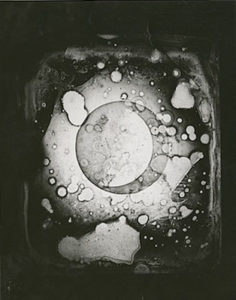
When we look up at the night sky, somewhere distant enough from the bleed of urban lights, we witness a living archive of light splayed out before us. A projection of the past Universe, not the one we share within our actual present in which we are witnessing it, but the receiving end of the rippling event of the image’s original emmision. Stars long dead and cold, stars exploded or imploded, stars of different colors in their stages of mortality…the image we are watching has already happened and has already changed drastically. That original moment we think we are witnessing has moved on, and even further from us as the Universe expands away, like the Angel of History, looking back in despair as it continues into the future. (Benjamin, IX).
It is an image of the past that fuels us with the desire to create narratives of gods and angels, the power to shrink us down to nothing and make us question existence itself, that allows us to project our own humanity upon it. An image from the past, now no longer. But living and present in our own experience of it, that is how we perceive and feel it, that power and that narrative coming from within us. This is a living archive. And as we travel further into it with both our imaginations and technology, we are beginning to have more and more the ability to even listen to it, and for it to be heard.[7]
Bibliography:
Barthes, Roland. 1985. “Listening”, in The Responsibility of Forms: Critical essays on music, art, and representation. New York: Hill and Wang.
Brentano, Franz. 1874. Psychologie vom empirischen Standpunkt. I. Hamburg: Felix Meiner. English translation: (1973) L. L. McAlister. Psychology from an Empirical Standpoint, London: Routledge
Cage, John. 1967. Silence, Lectures and Writing. Middletown, CT: Wesleyan University Press.
Chion, Michel. 1990. L’Audio-Vision. Paris: Editions Nathan. English translation: (1994). Audio-Vision: Sound on Screen. New York: Columbia University Press
Close, Cynthia. 2016. “Restoring the Lost Flaherty Classic ‘Moana With Sound’ in Documentary Magazine. <http://www.documentary.org/online-feature/restoring-lost-flaherty-classic-moana-sound> (accessed on February 26, 2016)
Deleuze, Gilles. 1985. Cinéma 2, L’Image-temps. Paris: Les Editions de Minuit. English translation: (1989). Cinema 2: The Time-Image. Minneapolis: University of Minnesota
Deleuze, Gilles., & Félix Guattari. 1991. What is Philosophy? Paris: Les Éditions de Minuit
Druckman, James N. 2001. “The Implications of Framing Effects for Citizen Competence” in Political Behavior. Doi:10.1023/A:1015006907312 (accessed on January 12, 2016)
Heuson, Jennifer. 2015. “Sounding Western: Frontier Aurality, Tourism, and Heritage Production In Sound Dakota’s Black Hills”. PhD diss., New York University
Maheshwari, Laya. 2014. “Why ‘Moana,’ the First Docufiction in History, Deserves a New Life” in IndieWire. <http://www.indiewire.com/2014/07/why-moana-the-first-docufiction-in-history-deserves-a-new-life-24631/> (accessed on February 16, 2016)
Merleau-Ponty, Maurice.1962. Phenomenology of Perception. New Jersey: The Humanities Press
Murch, Walter. 2000. “Structuring Sound to Help the Mind See”. New York Times. <http://www.nytimes.com/2000/10/01/arts/01MURC.html?pagewanted=all> (accessed on January 12, 2016)
Rancière, Jacques. 2008. “Aesthetic Separation, Aesthetic Community: Scenes from the Aesthetic Regime of Art” in Art & Research, Journal of Ideas, Contexts, and Methods, No. 1. Glasgow: Art & Research
Schafer, Raymond Murray. 1977. The Soundscape, Our Sonic Environment and the Tuning of the World. New York: Knopf
Sontag, Susan. 1969. “The Aesthetics of Silence” in Studies of Radical Will. New York: Farrar, Straus and Giroux
Suga, Nobuo. 1992. “Philosophy and Stimulus Design for Neuroethology of Complex-Sound Processing”. Philosophical Transactions of the Royal Society B: Biological Sciences. Royal Society Publishing
Toop, David. 2010. Sinister Resonance: The Mediumship of the Listener. New York, London; The Continuum International Publishing Group
Truax, Barry. 1984, 2001. Acoustic Communication. Westport: Ablex Publishing.
Filmography:
Moana. Flaherty, Frances H and Robert J. (1926). Moana With Sound. Flaherty, Monica. (1980, 2015). U.S.: Paramount Studios
The Birdpeople. Gitlan, Michael. (2005). U.S.: Flat Surface Films
The Motherhood Archives. Lustzig, Irene. (2013). Collaborative sound design by Colbert, Maile. U.S.: Women Make Movies
Endnotes:
[1] R. Murray Schafer, a Canadian composer, environmentalist, educator, and author, coined the phrase soundscape at Simon Fraser University in the 1960’s, where he began to teach soundscape studies. The phrase is used to describe the component of our acoustic environment that is perceived by humans, or “how that environment is understood by those living in it”. (Truax, 11)
[2] http://macaulaylibrary.org/audio/6784/campephilus-principalis-ivory-billed-woodpecker-united-states-louisiana-arthur-allen
[3] https://www.youtube.com/watch?v=7Qkc4HSKmJk
[4] http://macaulaylibrary.org/about
[5] http://www.birds.cornell.edu/ivory/featurepage/IBWO_movies
[6] Colbert, Maile., & Irene Lusztig, 2014. “Sound Designing Motherhood: Irene Lusztig & Maile Colbert Open the Motherhood Archives”. Sounding Out! Retrieved February 1, 2016, from http://soundstudiesblog.com/2014/03/17/sound-designing-motherhood/
[7] The sonification of the stars through NASA’s Kepler project, a building living archive: http://kepler.nasa.gov/multimedia/Audio/sonification/



